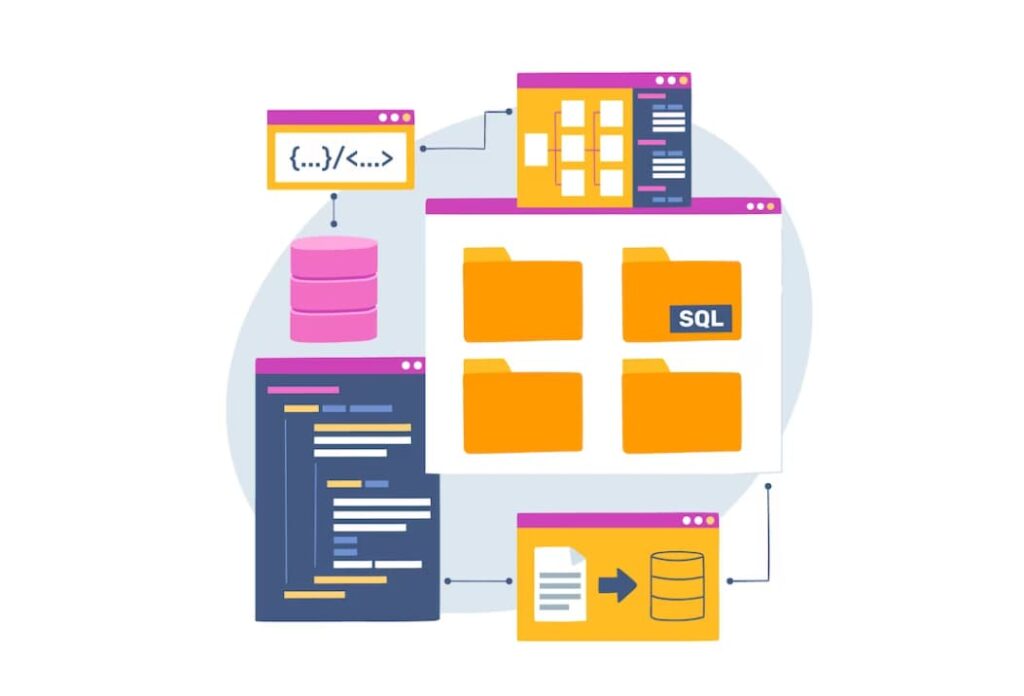In web development, JavaScript has emerged as the reigning king. The language’s versatility and extensive libraries have made it an indispensable resource for web developers worldwide. Indeed, a solid grasp of JavaScript and its popular libraries is vital for any budding web developer aiming to create dynamic web pages and applications.
This article provides a comprehensive review of key JavaScript frameworks and libraries drastically shaping web development trends in 2023. Such technologies have revolutionized web application development, providing developers with tools to create dynamic and interactive websites with ease and efficiency.
From the ascendency of JavaScript as a client-side scripting language to the advent of AJAX which made GUI faster and more responsive, JavaScript’s evolution has been remarkable. The introduction of jQuery further solidified JavaScript’s dominance in web development, providing developers with a tool to easily manipulate HTML documents and handle events, among other functionalities. The development of server-side components became a reality with the introduction of node.js, making it possible to develop a fully functional web application using only JavaScript.
Exploring the Top 10 JavaScript Libraries
As a web developer, it’s crucial to familiarize yourself with JavaScript libraries and understand how they can elevate your projects. This article covers top libraries like Angular, Ember.JS, Node.JS, jQuery, and ReactJS, among others.
Node.js
Node.js stands out as a distinguished framework in the JavaScript landscape, enabling programmers to craft server-side functionalities directly in JavaScript. This technology streamlines the creation of full-fledged web applications by utilizing an asynchronous, event-oriented architecture coupled with a non-blocking input/output system that significantly boosts performance.
- This versatile framework operates flawlessly across a multitude of operating environments, including Windows, Linux, Unix, and Mac OS X, and is available at no cost;
- It further distinguishes itself by offering an expansive repository of open-source modules found in its package manager, npm, which is renowned as one of the most extensive in the world.
React JS
The React framework, originating from the development teams at Facebook, provides a modular approach to building user interfaces through the use of self-contained components. Key features include:
- Emphasizing a declarative coding style, React ensures that user interface code is transparent and its behavior is straightforward, simplifying the debugging process;
- React’s versatile ecosystem allows for server-side rendering with Node, enhancing performance and SEO friendliness;
- With the extension to React Native, the same React principles and methodologies can be applied to mobile application development, promoting a unified development experience.
The framework is engineered for creating dynamic and responsive web applications that are both swift and efficient, enhancing the overall user experience.
This blend of capabilities enables developers to construct robust, high-performance applications across multiple platforms with ease.
Vue.js
Vue.js distinguishes itself within the realm of open-source JavaScript frameworks with its core feature of being incrementally adoptable. Its main characteristics include:
- Flexibility is at the forefront of Vue.js, allowing for smooth integration into projects that utilize other JavaScript libraries, making it an ideal choice for gradual adoption;
- The framework’s design emphasizes ease of integration, meaning that it can be introduced to existing projects with minimal disruption;
- Vue.js’s gentle learning curve ensures that developers can quickly become proficient, thereby accelerating development timelines;
- It fosters a progressive enhancement approach, enabling developers to scale the complexity of their applications as needed, starting with simple features and building towards advanced capabilities.
Vue.js’s approachable and versatile nature makes it a user-friendly and highly adaptable tool in the modern web developer’s toolkit.

jQuery
jQuery stands as a widely embraced JavaScript library, renowned for its rich set of capabilities that streamline web development. Its main features include:
- Robust API: jQuery delivers a comprehensive API that excels in managing events, crafting intricate animations, and manipulating the HTML document object model (DOM) with finesse;
- DOM Manipulation: It simplifies interacting with the DOM, allowing for effortless changes to elements and their attributes, enhancing interactivity and functionality;
- Event Handling: With jQuery, attaching events to elements is made intuitive, facilitating the creation of dynamic user experiences with less code;
- Animation and Effects: Developers can easily implement engaging animations and effects to improve the visual appeal of web applications without extensive coding;
- Complementary with Other Frameworks: jQuery’s versatility is evident in its compatibility with other prominent frameworks like Angular and React, where it can be used to augment application capabilities.
jQuery’s utility in augmenting complex web applications, alongside newer technologies, ensures its continued relevance in the fast-evolving landscape of web development.
Backbone.js
Backbone.js emerges as a significant JavaScript library, known for its lightweight approach to structuring web applications. It delivers several key features:
- RESTful JSON Interface: Backbone.js is engineered to facilitate a seamless connection between web applications and servers using a RESTful JSON interface;
- MVP Architecture: It implements the Model-View-Presenter pattern, providing a clear separation of concerns, which simplifies management and maintenance of code;
- Structured Web Applications: By offering a strong framework, Backbone.js is instrumental in bringing organization to complex web applications with numerous moving parts;
- Synchronization with API: It is adept at synchronizing data between the client and server, allowing web applications to interact smoothly with a RESTful backend.
Backbone.js equips developers with the tools to create well-organized, data-driven web applications that can effortlessly interface with a variety of backend services.
Ember.js
Ember.js stands out as an acclaimed open-source JavaScript framework tailored for crafting ambitious single-page applications. Its notable features include:
- Scalable Application Architecture: Ember.js is meticulously designed to facilitate the development of scalable single-page applications that can grow with your project’s needs;
- Convention over Configuration: It embraces a set of established conventions and best practices, streamlining the development process and reducing decision fatigue;
- Full-Featured Framework: As a full-fledged framework, Ember.js provides a comprehensive suite of tools that covers most aspects of application development without the need for numerous plugins;
- Templating Engine: Ember.js features an integrated templating engine, helping developers to efficiently create complex user interfaces.
Ember.js serves as a robust solution for developers looking to harness conventional wisdom and patterns in the pursuit of high-performance web applications.
Meteor JS
Meteor, also known as MeteorJS, is a comprehensive JavaScript platform that stands as a one-stop-shop for creating contemporary web and mobile applications. It boasts several prominent features:
- Full-Stack Solution: MeteorJS presents an all-inclusive framework, encompassing everything from the database to the user interface;
- Reactive Technologies: It specializes in building applications that instantly reflect server-side data changes on the client side, ensuring a reactive user experience;
- Build Tool: Comes with its own integrated build tool, which simplifies the development and deployment process;
- Curated Package Selection: MeteorJS offers a thoughtfully selected collection of packages, drawing from the broader Node.js and JavaScript ecosystem, enhancing functionality and reducing development time.
MeteorJS is geared towards developers aiming to rapidly produce cross-platform applications with a responsive interface and a cohesive development experience.
Angular
Angular, initially released as AngularJS, is a robust platform for building web applications, crafted and maintained by Google. It’s engineered to support the development of progressive and dynamic web apps with a host of features:
- Progressive Framework: Angular is tailored for the development of cutting-edge progressive web applications;
- Dependency Injection: The framework stands out with its dependency injection mechanism, streamlining the creation and management of data services throughout the application;
- Component-Based Architecture: It employs a modular structure that breaks down applications into reusable and manageable components.
Angular has positioned itself as a prime choice for developers focused on constructing high-performance, maintainable web applications that require a solid, feature-rich framework.
Polymer JS
Polymer JS is an open-source JavaScript library from Google, designed to empower developers in crafting custom, reusable components for web applications. Its core attributes include:
- Custom HTML Elements: Polymer provides the tools to define and create new HTML elements, offering expansive possibilities for web component customization;
- Reusability: It emphasizes the creation of components that can be easily reused across different parts of an application or in other projects, promoting maintainability and consistency;
- Performance: By enabling developers to build lightweight and well-encapsulated elements, Polymer contributes to building applications that are both efficient and fast;
- Maintainable Codebase: Applications built with Polymer are structured in a way that makes them easy to manage and scale over time.
As a result, Polymer JS is particularly suited for developers seeking to extend the HTML language itself and who require a library that encourages the creation of maintainable and high-performing web applications.

Webix
Webix stands as a versatile JavaScript UI library, emphasizing the creation of rich, cross-platform web applications. Its suite of complex widgets includes:
- Diverse Widget Collection: Featuring advanced widgets such as Kanban boards, File Managers, Spreadsheets, Schedulers, and Pivot tables, Webix is equipped to tackle a variety of UI needs;
- Seamless Integration: These widgets are crafted to integrate smoothly with existing projects, enhancing functionality with minimal hassle;
- Cross-Platform Functionality: Webix’s design caters to a consistent user experience across various devices and platforms, enabling developers to build universally compatible web apps.
With its comprehensive range of interactive widgets, Webix is a potent tool for developers aiming to rapidly deploy feature-rich and responsive user interfaces.
Conclusion
The JavaScript frameworks and libraries mentioned above have significantly streamlined and improved web development. Each offers unique features and functionalities that cater to different development needs. As a web developer, discovering and mastering these tools is crucial to create dynamic, functional, and high-performing web applications.
